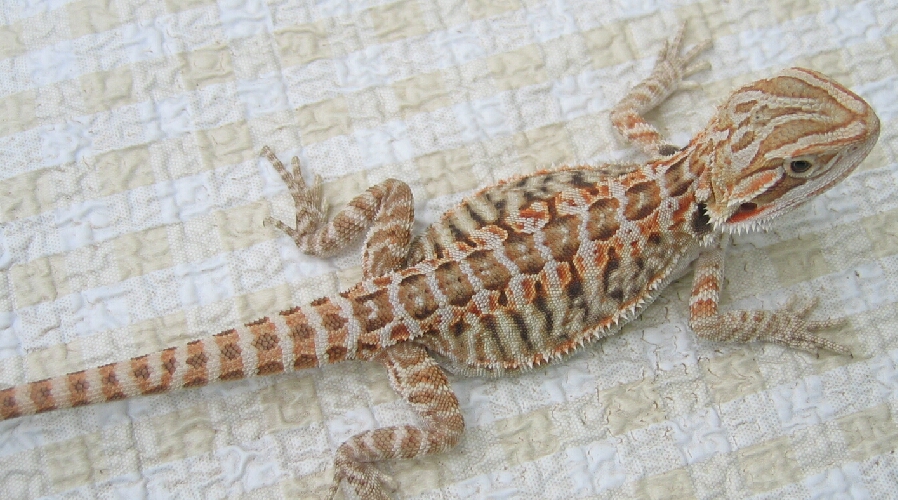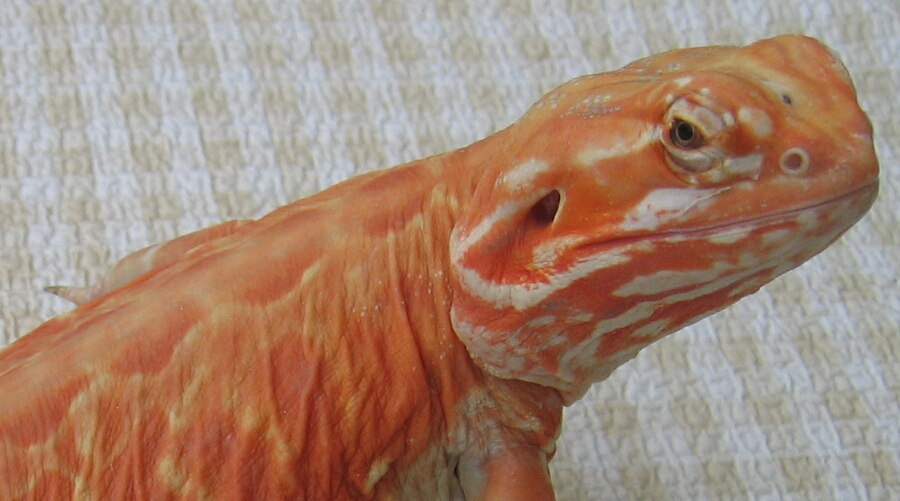Leatherbacks / Silkbacks
LeatherBacks
Leatherbacks are dragons that display an absence or reduction of tubercles (rough scales) on the dragons back which give them a leathery appearance. There've been very few of them hatched in captivity; making these extremely rare. We occasionally hatch leatherbacks from a variety of lines, but haven't had success with our projects of reproducing the trait with the 'flukes' we've produced here in the past.

There is also a private breeder in California who consistently produces leatherback dragons from what is believed to be a recessive mutation.
Late 2006 we had an opportunity to import a new line of Leatherback dragons from a private breeder in Italy. These leatherback dragons are really cool looking - showing minimal tubercles and reduced scale size througout their body. If an Italian Leatherback is bred to a normally scaled dragon, the offspring result in approximately 1/2 regular scaled and 1/2 leatherback. In our experiences, this form of tubercle reduction is consistent and doesn't produce "partial" leatherbacks. In addition to reproduction predictably, these leatherbacks are actually a visible HET for a super form - A scaleless...AKA "Silkback" dragon.
The leatherback dragons dont need any different husbandry or additional care when compared to a normal dragon. The scales are present, just reduced.
SilkBacks
The scaleless or "Silkback" dragon is a result of a breeding project which pairs 2 leatherback dragons together. Silkback dragons dont have 'chip' scales or tubercles on their backs or ventral sides. The lateral spines are also absent from silkback animals. With the absence of scales, the actual coloration of the animal is much more vibrant. (This particular Silkback female is a sibling/clutchmate to the leatherback male in the top picture!)

More detailed husbandry information...
We own one female Silkback that we imported from Italy in Oct. 2006.
All of the adult animals here are housed in melamine enclosures with 2 fluorescent bulbs (one is a 5.0) and a low watt basking bulb (15-50 watt depending on the season). The dragon's cages are also modified to allow for increased airflow and the humidity in our house runs usually around 50%. All lights come on in the morning and due to the low wattage basking bulbs being used, the cages warm up slowly - as does the room temperature. Anywhere between noon-4pm we usually shut off the heat lights. Since the ambient temperature in the room is higher and the fluorescent are fairly close (approx. 8 inches) to the animal - if they choose, they can remain on the basking area and maintain a higher body temp. Adult dragons respond well to an average body temperatures of around 90-92 - having an occasional peek at the 96 range. We choose to gradually warm the dragons to a peek temperature and then slowly allow their temperatures to drop back down to ambient - this works well for us. Using this husbandry method also allows for a slight increase of overall humidity in the cage - we dont bump the humidity in the cage by spraying. In general, the cage humidity is usually slightly lower than the room humidity.
Bearded Dragons and Frilled Lizards -
“The average body temperature of bearded dragons in the wild is around 91 degrees. In captivity, these lizards appear to have a higher preferred temperature of around 96 degrees.”
Does allowing dragons to bask at high temperatures for a long duration every day actually promote health? Is this natural? In the USA, prolonged, higher heat is usually used - causing much drier conditions. So when we say that we offer “slightly increased humidity” it is in comparison to popular husbandry practices.
Bearded dragons certainly dont need a 110 basking temperature to properly digest their food. Dragons all digest their food and poo just fine at lower temperatures. Could you keep a Silkback at a higher temperature and avoid problems? We don’t know. There was a study done on heat transfer which compared a scaleless gopher snake to a normally scaled gopher snake and not much of a difference was noted between the 2.
“Optimal” care / husbandry for bearded dragons (as a whole) is based upon opinion. Optimal care varies according to the individual dragons needs / preferences and it is our job to provide what in our opinion is optimal care. We feel we have done this across the board for all of our dragons - those with and the one without scales…
As for the lack of scales making Ruby too fragile to act like a normal beardie without causing herself injury - No. Ruby is not falling apart. Yes, Ruby's skin is soft and smooth and isn't covered in scales or tubercles, therefore more fragile than that of a scaled animal. She acts like any other bearded dragon and hasn't accidentally caused a skin tear yet... still watches everything going on in the room, chases crickets and roaches, splashes around and blows up like a bubble in water to float. We haven't bred Ruby and therefore cannot comment on how the skin will hold up through a breeding season. But she was caged with another animal when younger - and received a bite on her tail. The bite was a good one and broke her skin - but it healed just fine and the bite mark is barely noticeable. There were no infections involved. Based on this incident, one would assume that physical breeding could cause harm - especially if the male is aggressive. ((There are other ways of fertilizing a female that offer no direct contact - this has been proven by many. Plus, a Silk doesn't need to be bred to create another Silk.))
Ruby's skin, while shedding is thinner than a normal dragons shed and does not seem to have the elasticity of scaled shed. Close attention must be given to the skin around the digits and tail to prevent rolling or constriction (like a gecko)… During her shedding process, we will occasionally dampen a paper towel and leave it in the cage.
Another concern of ours was the pads of her hands and feet. Ruby hasn't formed, and probably cannot form, any calluses in this area and therefore pressure sores were a concern. We've seen none as of yet.
The physiological aspect of scales concerning water retention was also addressed in the gopher snake study mentioned above.
Ruby is not dehydrated nor does she drink much when offered water. When soaking in water for a bath, she doesn't “prune up” like human hands do.
Differentiation of the epidermis during scale formation in embryos of lizard is another article that is full of information on scales and their formation.
It seems to us that Ruby’s skin does not complete the folding process… nor I suppose, does the keratinization process finish - Whatever it is exactly that happened, it hasn't effected anything else that we've noticed. She is now 17 inches, has nails and teeth and her skin isn't overly sensitive to touch during handling. She is a happy, outwardly healthy bearded dragon - minus scales.
Hope this addresses some of the concerns.
Rob & Vickie